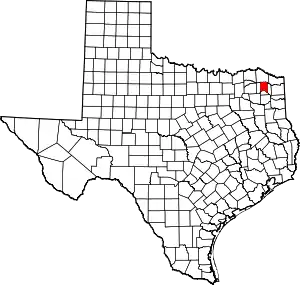Talco, Texas | |
|---|---|
.jpg.webp) Talco City Hall | |
 Location of Talco, Texas | |
 | |
| Coordinates: 33°21′44″N 95°6′15″W / 33.36222°N 95.10417°W | |
| Country | United States |
| State | Texas |
| County | Titus |
| Area | |
| • Total | 0.77 sq mi (1.99 km2) |
| • Land | 0.77 sq mi (1.98 km2) |
| • Water | 0.00 sq mi (0.00 km2) |
| Elevation | 364 ft (111 m) |
| Population (2010) | |
| • Total | 516 |
| • Estimate (2019)[2] | 497 |
| • Density | 648.83/sq mi (250.67/km2) |
| Time zone | UTC-6 (Central (CST)) |
| • Summer (DST) | UTC-5 (CDT) |
| Zip Code | 75487 |
| FIPS code | 48-71732[3] |
| GNIS feature ID | 1369562[4] |
Talco is a town in Titus County, Texas, United States. The population was 516 at the 2010 census. The name is derived from a local candy bar (It was either a shelf carton or because the local people said it was "Texas-Arkansas-Louisiana Country hence Talco). Also reports said it may have been a local company name Texas-Arkansas-Louisiana Company. There are varying reports to what it was actually.
History
Two post offices were established near the current site of Talco: Gouldsboro in 1856 and Goolesboro in 1878. Due to name conflict the community changed its name to "Talco" based on the Texas, Arkansas, and Louisiana Candy Company initials on a candy wrapper. In 1912, Talco relocated to be closer to a railroad line.
Oil was discovered in 1936, leading to a big boom in the economy. Talco called itself the "Asphalt capital of the world."
Geography
Talco is located at 33°21′44″N 95°6′15″W / 33.36222°N 95.10417°W (33.362131, –95.104090).[5]
According to the United States Census Bureau, the city has a total area of 0.8 square mile (2.0 km2), all land.
US Route 271 is the major north–south highway passing through Talco. The community is one mile east of the Franklin County line.
Demographics
| Census | Pop. | Note | %± |
|---|---|---|---|
| 1940 | 912 | — | |
| 1950 | 917 | 0.5% | |
| 1960 | 1,024 | 11.7% | |
| 1970 | 837 | −18.3% | |
| 1980 | 751 | −10.3% | |
| 1990 | 592 | −21.2% | |
| 2000 | 570 | −3.7% | |
| 2010 | 516 | −9.5% | |
| 2019 (est.) | 497 | [2] | −3.7% |
| U.S. Decennial Census[6] | |||
| Race | Number | Percentage |
|---|---|---|
| White (NH) | 220 | 44.53% |
| Black or African American (NH) | 81 | 16.4% |
| Native American or Alaska Native (NH) | 6 | 1.21% |
| Some Other Race (NH) | 1 | 0.2% |
| Mixed/Multi-Racial (NH) | 30 | 6.07% |
| Hispanic or Latino | 156 | 31.58% |
| Total | 494 |
As of the 2020 United States census, there were 494 people, 258 households, and 206 families residing in the city.
Education
The City of Talco is served by the Rivercrest Independent School District (Talco-Bogata Consolidated Independent School District prior to July 1999).[10]
It previously maintained Talco Elementary.[11] The previous Talco school opened in 1939.[12] The district began construction of the consolidated elementary on May 1, 2000 and the scheduled completion was in June 2001.[10]
References
- ↑ "2019 U.S. Gazetteer Files". United States Census Bureau. Retrieved August 7, 2020.
- 1 2 "Population and Housing Unit Estimates". United States Census Bureau. May 24, 2020. Retrieved May 27, 2020.
- ↑ "U.S. Census website". United States Census Bureau. Retrieved January 31, 2008.
- ↑ "US Board on Geographic Names". United States Geological Survey. October 25, 2007. Retrieved January 31, 2008.
- ↑ "US Gazetteer files: 2010, 2000, and 1990". United States Census Bureau. February 12, 2011. Retrieved April 23, 2011.
- ↑ "Census of Population and Housing". Census.gov. Retrieved June 4, 2015.
- ↑ "Explore Census Data". data.census.gov. Retrieved May 21, 2022.
- ↑ https://www.census.gov/
- ↑ "About the Hispanic Population and its Origin". www.census.gov. Retrieved May 18, 2022.
- 1 2 "Home". Rivercrest Independent School District. May 15, 2001. Archived from the original on May 15, 2001. Retrieved October 30, 2019.
- ↑ "Talco-Bogata Cons ISD Data". Texas Education Agency. May 4, 2001. Archived from the original on May 4, 2001. Retrieved October 30, 2019.
- ↑ "Home". Talco Elementary and Junior High. April 8, 2001. Archived from the original on April 8, 2001. Retrieved October 30, 2019.
External links
- Talco, TX history
- Riches Loom for Village Folk in Texas Oil Rush from the Texas Archive of the Moving Image
- https://news.google.com/newspapers?nid=861&dat=19670621&id=D_cnAAAAIBAJ&sjid=NlYDAAAAIBAJ&pg=2803,4782694.
